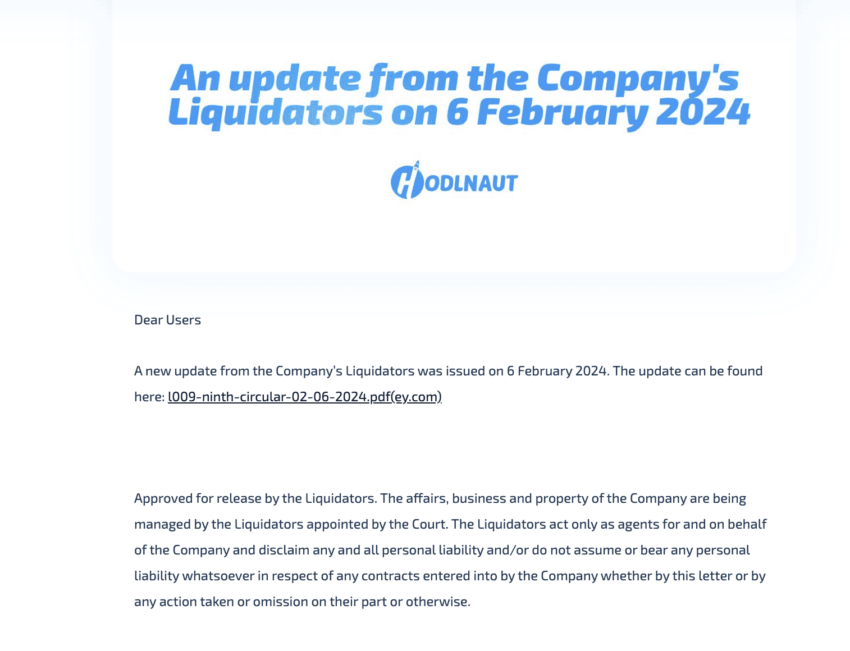There are a number of companies in the crypto space — exchanges, lenders, hedge funds, payment processors — whose operations can impact broader market sentiments. If any of these key institutions were to go bankrupt, they would likely take sizable market chunks down with them. This guide explores some of the most impactful crypto bankruptcies, which have changed how the industry considers compliance, security standards, risk management, and the associated economic consequences.
- Key crypto meltdown events
- Genesis Global (2023)
- FTX (2022)
- BlockFi (2022)
- Three Arrow Capital (2022)
- Celsius Network (2022)
- Voyager Digital (2022)
- Hodlnaut (2022)
- Zipmex (2022)
- Core Scientific (2022)
- Insolvency in crypto before 2022
- Cryptopia bankruptcy (2019)
- Other scams that came close to bankruptcy
- Is Binance in trouble?
- How investors can navigate crypto bankruptcies
- Frequently asked questions
Key crypto meltdown events
Over the years, numerous failed crypto projects have led to eventual crypto bankruptcies. While we shall discuss a number of these in detail, here’s a quick summary of some of the key events.
In 2014, the Mt.Gox bankruptcy was led by a host of security breaches and resulted in a loss of 850,000 BTC. Then, there was the QuadrigaCX bankruptcy, which resulted in sizable investor losses due to financial mismanagement and lack of proper risk management strategies. Perhaps the most well-known crypto bankruptcy, however, was the FTX collapse in late 2022, led by the now-convicted Sam Bankman Fried.
And these are only a handful of failed crypto projects. Read on as we thoroughly explore the notable crypto bankruptcies, with the most recent events explained first.
Did you know?
Investigative sleuthers and handles like CoffeeZilla can help you track the status of both new and established crypto projects. This can help you navigate the space better and stay informed about possible scams, rug pulls, and other crypto bankruptcies.
Genesis Global (2023)
Genesis Global, a popular crypto trading and lending firm, imploded due to the severe liquidity crisis. Let us delve deeper into the aspects that impacted the positioning of this Digital Currency Group subsidiary.
Reasons
Genesis Global was overexposed to several less-than-transparent firms, including FTX and Three Arrows Capital. So when those institutions imploded, the entire machinery of Genesis Global felt the ripple effect. Genesis Global even kickstarted the Barry Silbert-led DCG group’s downfall as the extensive lending operations backfired.
Here’s how on-chain metrics could have saved investors:
Eventually, the company filed for Chapter 11 (bankruptcy protection), listing liabilities to the tune of $11 billion. Over 100,000 creditors, per the company details, were impacted.
Impact
- Market turmoil
- Frozen assets leading to investor losses
- Creditor uncertainty
Current status in 2024
The bankruptcy proceedings are ongoing, and a number of investors are still waiting to receive any compensation. In terms of recovery plans and asset sales, Genesis intends to sell shares to the Grayscale Bitcoin Trust and other establishments to raise approximately $1.6 billion.
Lessons learned
- The market is in need of robust liquidity management
- The risk exposure of the crypto firms needs to be far more diversified
- There is no substitute for regulatory oversight and compliance
- Financial entities in the crypto space are highly interconnected, and therefore, financial management and due diligence need to be prioritized.
FTX (2022)
The FTX crisis was the primary bear market event, where most cryptocurrencies bottomed out. As we know, Solana (SOL) was one of the majorly impacted cryptocurrencies.
Reasons
FTX was one of the largest cryptocurrency exchanges in the world. However, in November 2022, a series of investigative insights highlighted that this firm was working too closely with sister firm Alameda Research, also founded by Bankman-Fried. Customer deposits on FTX were being misused to cover Alameda’s losses.
As the news broke, FTX experienced a bank run with many users trying to withdraw funds at the same time. As the exchange couldn’t meet the massive bankruptcy requests, it was forced to file for bankruptcy on Nov. 11, 2022. FTX and the concerned affiliates reported having assets and liabilities in the $10 billion to $50 billion range.
Following the meltdown, a new CEO, John Jay Ray III, was appointed to navigate and oversee the restructuring process.
Impact
- Investor and customer losses
- Enhanced regulatory scrutiny
- Market destabilization as FTX had to sell massive crypto holdings to cover the shortfall
Current status in 2024
Andrew Dietderich, an FTX Lawyer, stated in January 2024 that FTX creditors and customers will be paid in full. This process is still in the works. At present, the now-defunct organization plans to distribute $9 billion to cover some compensation claims.
Lessons learned
- Importance of stakeholder transparency, especially the way funds are managed
- Proper risk management strategies
- Importance of internal controls and corporate governance
BlockFi (2022)
BlockFi, a leading crypto lending firm, was impacted by the financial distress experienced by FTX. It is known that BlockFi extended a $400 million credit line to FTX in addition to several direct investments.
Crypto failures are interconnected:
Reasons
When FTX experienced a liquidity crisis, the perils of financial mismanagement rubbed onto BlockFi. The company had exposure to FTX and Alameda Research, which ensured that most of the assets were unrecoverable after the FTX collapse. While filing for bankruptcy, BlockFi reported assets and liabilities in the $1 billion to $10 billion range.
These included $355 million worth of locked cryptocurrency on FTX and a defaulted loan worth $671 million to Alameda.
Impact
- Frozen customer and investor funds
- Eroding market confidence
- Regulatory reactions
Current status in 2024
The recovery efforts associated with BlockFi are ongoing. There has been a judicial decision concerning a repayment of $300 million to the creditors. Recovery percentages vary anywhere between 39% and 100%.
Lessons learned
- Exposure management is key when it comes to lending and investment
- Financial platforms must adhere to the end-to-end risk disclosure
- Crypto companies need to have robust contingency plans
Three Arrow Capital (2022)
This Singapore-based crypto hedge fund shut shop in June 2022. Here is what went down and how the market was impacted.
Reasons
The fund had heavy exposure to volatile crypto strategies and assets. Plus, there was significant leverage involved. Also, when the TerraUSD debacle led to LUNA’s death spiral and a major correction across multiple cryptocurrencies, the liquidity crisis for 3AC became harder to manage. The fund couldn’t meet margin calls associated with its leveraged positions and went bankrupt.
Impact
- Market contagion that took down the likes of Voyager Digital and BlockFi by making them unstable in the first place
- Significant investor losses, making the high-risk investment vehicles less desirable
- Increased regulatory scrutiny
Current status in 2024
3AC filed for Chapter 15, securing assets from U.S. creditors amid liquidations. The total creditor claims reached as high as $3.5 billion, whereas the estimated assets, as of July 2023, stood at $1 billion. While the bankruptcy proceedings are ongoing, it is believed that 46% of the credit claims could be responded to.
Lessons learned
- Investor education is important as they need to understand how crypto hedge funds operate.
- Increased transparency from funds, especially when there is exposure to high-risk markets
- Short positions, like the ones implemented by Ethena Finance, are important to combat bear market risks.
Celsius Network (2022)
Celcius was a leading firm in the staking and lending space. The company declared bankruptcy in July 2022.
Reasons
The collapse of the Terra-Luna ecosystem was one of the major reasons that Celsius was forced to file for Chapter 11. The company was over-leveraged, made a series of poor investment decisions, and was pushed to the brink by a rapid withdrawal of funds by nervous investors.
Impact
- Widespread distress leading to frozen assets
- Need for regulatory scrutiny
- Dwindling market confidence
Current status in 2024
The recovery efforts seem to have concluded, and in January 2024, the company distributed assets worth $3 billion to creditors. Plus, the company has also revealed its plans to establish a Bitcoin mining entity to generate compensatory revenue further.
Lessons learned
- Companies like Celsius need to focus more on risk management
- Customers need to get clear info about the way firms are using assets to generate profits
- Stricter compliance is the need of the hour
Voyager Digital (2022)
Voyager, a brokerage and lending firm, entered bankruptcy proceedings in July 2022.
Reasons
Voyager’s implosion followed the TerraUSD crash. As 3AC went down, it defaulted on a large credit line extended to 3AC, which caused unrest and negatively impacted Voyager’s health.
Impact
- Negative impact on the broader financial ecosystem
- Eroded market confidence, which questioned the stability of crypto financial services
Current status in 2024
At the time of filing — July 2022— Voyager reported liabilities worth $5.7 billion. Voyager initially planned to sell its assets to FTX U.S. for $1.4 billion, a move that would have helped creditors recover almost 72% of the claims. However, before this could happen, FTX collapsed, too, leaving the deal to fall through. As of 2024, the company has managed to return funds worth $270 million to the clients, and it even entered a deal worth $1 billion with Binance U.S.
This means Voyager customers could potentially expect 35.72% of their claims to get addressed.
Lessons learned
- Customer due diligence is of paramount importance
- Regulatory and compliance frameworks need to underline crypto services
- Crypto companies should limit exposure to high-risk counterparties
- Diversification and stringent assessment specific to the counterparty assessments are required
Hodlnaut (2022)
The collapse of the Terra ecosystem didn’t only impact the U.S-based firms. The ripples were felt globally. Hodlnaut, a Singapore-specific lending platform, was also forced to shut shop following these events.
Reasons
The company faced severe liquidity issues and halted swaps, withdrawals, and even deposits in August 2022. It had allowed users to borrow against crypto deposits, a use-case that eventually made it vulnerable. When the market began correcting, the value of Hodlnaut’s collateral started dipping, leading to a massive liquidity shortfall.
Impact
- Heightened fear across the lending space
- Loss of trust among investors
Current status in 2024
The company is going through a restructuring phase led by judicial inputs.

Lessons learned
- Regulatory oversight for these crypto use cases is paramount
- Due diligence is necessary
- Companies need to be prepared for longer market volatility spells
- Proper risk management strategies should be in place
Zipmex (2022)
This Southeast Asia-based cryptocurrency exchange catered to Thailand, Indonesia, Australia, and Singapore before going bust in 2022.
Reasons
The financial distress surrounding Zipmex amplified when two of its biggest borrowers, Celsius Network and Babel Finance, started facing a liquidity crisis. The loans were defaulted, exposing Zipmex’s erroneous financial stance.
Impact
- Exchanges involved in lending and borrowing using investor funds lost a lot of ground.
- Several interconnected risks in the crypto space surfaced
Current status in 2024
The company is still involved in a restructuring process presided over by the Singapore court. During the bankruptcy filing, Babel Finance and Celsius owed $48 million and $5 million to Zipmex, respectively.
Lessons learned in 2024
- Lack of diversification can lead to vulnerabilities
- Risk management is a reliable way to navigate market volatility
Core Scientific (2022)
It isn’t only about lending firms or exchanges impacted by bankruptcies. Core Scientific, one of the largest Bitcoin miners in North America, filed for Chapter 11 in December 2022.
Reasons
An extended bear market followed by rising energy costs, increased mining difficulty, and piled-up debts were some of the reasons that Core Scientific had to shut shop.
Impact
- Highlighted the risks associated with Bitcoin mining, especially during periods of prolonged correction.
Current status in 2024
As of 2024, Core Scientific has emerged from the bankruptcy hit, mining 19,274 BTC in 2023 alone. Its post-bankruptcy reorganization process is complete, and it is also currently trading on NASDAQ (as of April 23, 2024) at close to $3 per share.
Lessons learned
Even mining firms need to diversify business operations and revenue streams to mitigate the threats of market volatility. It is worth noting that most of the crypto bankruptcies in 2022 were interconnected, exposing the over-reliance of key players on major liquidity providers and creditors.
Insolvency in crypto before 2022
Even though 2022 and even 2023 saw the most impactful cryptocurrency bankruptcies, such events really started back in 2014 with the Mt.Gox bankruptcy. Since then, several crypto bankruptcies have surfaced, every now and then, led by security breaches, financial mismanagement, exit scams, and others. Here’s some insight into some other key events.
Blockchain Global (2021)
This Australian crypto firm declared voluntary administration or bankruptcy in November 2021, led by a culminating debt that exceeded $15 million. Plus, one of its subsidiaries, the Australian Crypto Exchange or ACX, also halted its operations at that time, putting additional pressure on Blockchain Global.
ACX (2020)
ACX, an Australian crypto exchange, declared bankruptcy in February 2020. The company ceased its exchange abruptly. Investor losses worth $10 million were recorded, which in turn forced the Victoria Supreme Court to issue a freeze order on ACX’s BTC holdings.
FCoin (2020)
This Singapore-based exchange declared bankruptcy in February 2020. Its controversial transaction mining business model fueled concerns of unsustainable cash flows. Accusations involving financial mismanagement and concerns related to exit scams and related frauds sealed the deal.
Cred (2020)
This U.S-based crypto lending platform filed for Chapter 11 in 2020, driven by fraudulent activities, mismanagement, and poor investment choices. Cred gave out high-interest loans to moKredit and other third-party entities, expecting high profits — a move that backfired. Plus, a fraudulent asset manager was accused of misappropriating 800 Bitcoins via an entity called Quanticon.
Did you know? James Alexander was named as the fraudulent asset manager who was implicated in the 800-BTC fund misappropriation fiasco.
Cryptopia bankruptcy (2019)
This New Zealand-specific exchange was breached in 2019, with hackers managing access to the user wallets. The hack led to huge financial losses and forced Cryptopia to shut down operations and liquidate.
QuadrigaCX bankruptcy (2019)
QuadrigaCX was one of the largest Candian exchanges, which went bust after the unexpected death of Gerald Cotten, its CEO. Cotten, supposedly, was the only person with access to the firm’s cold wallets, and his death ensured a loss of almost $190 million in customer funds. Some folks still consider it one of the better-devised exit scams.
Bitconnect (2018)
The Bitconnect bankruptcy or shutdown was essentially a disguised Ponzi scheme. The platform was aggressive in offering a 40% return to users, primarily by reinvesting user funds. However, the regulatory crackdown stunted its operations, leading to investor losses to the tune of $1 billion.
Mt.Gox (2014)
Mt.Gox was once the largest Bitcoin exchange. In 2014, it experienced a massive security breach worth 850,000 BTC, led by poor management, technological flaws, and security lapses. Investors indulged in extended legal battles until 2021, when the rehabilitation plan for the distribution of assets was approved.
Other scams that came close to bankruptcy
Besides the mentioned cryptocurrency bankruptcies, there were a handful of other scams that impacted the associated companies beyond measure. Here are the notable ones:
Bitfinex
In 2016, Bitfinex, one of the largest Bitcoin exchanges, was hacked. Almost 120,000 Bitcoins were compromised, accounting for a massive loss figure of up to $72 million at the time. Even though they managed to avoid bankruptcy, a controversial strategy of introducing BFX tokens to make customers whole was introduced.
It is worth noting that platforms launching tokens just for the sake of covering losses or raising capital isn’t a good practice. It can also be a major scam-specific red flag.
DAO attack
The DAO, a venture capital body backing Ethereum, faced a smart contract hack in 2016. Almost $50 million worth of funds were compromised, which didn’t lead to bankruptcy but caused a split across the Ethereum community — a fork separating Ethereum Classic and Ethereum.
Parity wallet freeze
This anomaly in 2017 started as a multi-sign vulnerability specific to the Parity wallet. However, it quickly escalated into a $280 million ETH freeze. This issue highlighted the risks associated with smart contract bugs.
Coincheck hack
This Japan-based exchange suffered a huge security breach in January 2018. Hackers stole NEM or XEM tokens worth $534 million from the exchange’s hot wallet, resulting in reputational and financial damage. The company eventually compensated investors using its own capital.
Babel Finance (2022)
Babel Finance had to go through a restructuring process in 2022 as it faced liquidity issues and had to halt withdrawals. Customer funds worth $280 million were compromised, citing that Babel sought bankruptcy protection in 2022. However, the court granted them an extension and time to restabilize and restructure.
Is Binance in trouble?
While everything looks well with Binance operationally, the largest crypto exchange has faced its share of issues. The CEX was ordered to pay $4.3 billion as part of a settlement with the Department of Justice. Plus, it continues to be at the center of endless regulatory scrutiny. While the exchange has been limited in a number of locations across the globe, the CEX has ramped up compliance efforts to the extent that it will resume operations in India in 2024.
How investors can navigate crypto bankruptcies
While investors do not have any control over crypto bankruptcies, there are a number of precautions that can be taken. Ensure to invest time in due diligence, opt for portfolio diversification, rely on cold wallets, and only interact with regulated platforms. As always, never invest more than you can comfortably afford to lose.
Frequently asked questions
Why did the FTX collapse?
How many crypto companies have failed?
Will I get my crypto back from FTX?
Did anyone from BitConnect go to jail?
How much is the BitConnect scam worth?
Trusted
Disclaimer
In line with the Trust Project guidelines, the educational content on this website is offered in good faith and for general information purposes only. BeInCrypto prioritizes providing high-quality information, taking the time to research and create informative content for readers. While partners may reward the company with commissions for placements in articles, these commissions do not influence the unbiased, honest, and helpful content creation process. Any action taken by the reader based on this information is strictly at their own risk. Please note that our Terms and Conditions, Privacy Policy, and Disclaimers have been updated.




